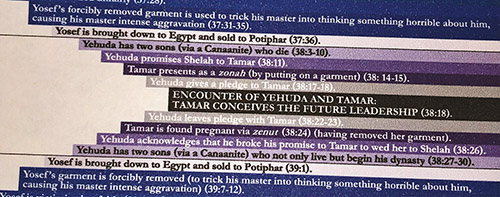

It was the fall of 2018, and as he was studying the parsha of the week, Parshat Vayeishev, David Schwartz noticed something that he had not seen before. And when he looked further into it, the phenomenon gradually grew bigger and bigger.
David had spotted a previously undocumented chiastic pattern in a large segment of the Torah.
Wikipedia defines chiastic structure, or chiastic pattern, as “a literary technique in narrative motifs and other textual passages. An example of chiastic structure would be two ideas, A and B, together with variants A’ and B’, being presented as A,B,B’,A’.” The analysis of chiastic patterns in the Torah is one approach embraced by noted modern-day Tanach teachers such as Rabbi Menachem Leibtag, Rabbi Yoel Bin Nun and others (see, for example: https://outorah.org/p/37574/).
Chiastic structures can be as short as the example given in the Wikipedia entry or longer. As Schwartz wrote later: a chiastic pattern “reveals and emphasizes the thematic underpinnings to a narrative as a whole and it serves as a tool in the interpretation of discrete episodes and their significance as parts of that whole.”
As Schwartz discovered, a chiastic pattern can be big enough to span hundreds of verses and themes in entire books of the Torah.
Mind you, David Schwartz was a busy guy who probably wasn’t looking for a novel project that took up a good part of two years to fully investigate, document, then publish. Although he has rabbinic ordination from Yeshiva University, he works as a full-time investor and a managing director at Serengeti Asset Management in New York City. He and his wife Bena are raising five children in the Country Club section of Teaneck. He also serves as president of the Young Israel of Teaneck, a role he’s held for nearly four years.
Still, when inspiration strikes, you follow it.
Schwartz initially identified the chiastic pattern surrounding the physical encounter of Yehuda and Tamar (Bereishit 38:18), noting that it is framed by Yehuda giving a pledge to her beforehand (38:17-18) and leaving it with her afterward (38:22-23). That, in turn, is bracketed by Tamar dressing as a zonah (38:14-15) and later being found pregnant and assumed to have acted wantonly (38:24). This correspondence is surrounded by Yehuda first promising to marry his son Shelah to her (38:11) and later admitting that he broke that promise (38:26). This short chiastic pattern, Schwartz learned later, had already been noted by others.
But as he explored further, Schwartz saw that the chiastic pattern continued through the entire parsha. He continued mapping the themes he encountered, in earlier and later chapters, and found that it went further and further. He eventually discovered that the chiastic pattern encompassed the entire narratives of the books of Bereishit through Shemot.
As Schwartz explains his discovery: “You can basically divide the Torah into two sections. The first half, Bereishit and Shemot, is the extended narrative providing the story of the creation of the chosen nation. Chosen not in the sense of privilege or superiority, but in the sense of being charged with the responsibility of bringing God into this world (symbolized by the Mishkan), by being a light unto the nations, through living according to God’s law. Then the second half is dominated by the articulation of that law itself.”
David grew excited at his discovery and, with input and support from his wife Bena, son Yaakov (now studying in the Gush), and Rabbi Dr. Yonatan Grossman of Bar Ilan University, he wrote a scholarly article explaining his findings and created a color-coded chart to illustrate the full chiastic pattern. He submitted the article and illustration to the respected scholarly publication Hakirah: The Flatbush Journal of Jewish Law and Thought, and after a peer-review process, the journal accepted the article for publication. The article is published in the current winter 2020/2021 issue; per the journal’s standing policy, the article (along with others in this issue) will be accessible online after the next issue is published. The Hakirah Journal is available for sale in print in many local Judaica stores, such as Judaica House in Teaneck.
Schwartz explains that the chiasm he discovered “reveals a deep, hidden pattern and organization to the first half of the Torah, the story of the creation of the chosen nation. The article explains and develops this theme of continual choosing and then crystallization into a nation. The chiasm comprehensively covers and includes pretty much the entire narrative of all of Bereishit and Shemot. And substantially all of the 38 ‘pairs’ in the chart not only constitute chiastic parallels but also substantively highlight and further or deepen this theme.”
David’s discovery has been praised by some noted readers of the journal.
“David Schwartz’s novel hypothesis breathes new meaning into seeking the forest in Torah study,” said Rabbi Hayim Angel, national scholar with the Institute for Jewish Ideas and Ideals, a Bible Department faculty member at Yeshiva University and a Tanach faculty member at the Beit Midrash of Teaneck. “His global reading of the books of Bereishit and Shemot will serve as an eye-opener to many, especially those who are intricately familiar with the narratives. Schwartz’s theory is an invitation to seek macro-structures within the Torah, and no doubt will refine our learning in the thoughtful conversations it will elicit for years to come.”
Heshey Zelcer, a member of the editorial board of Hakirah, stated succinctly: “David Schwartz’s unique chiasm turns our attention to a pivotal event in history, the creation of the chosen nation.”
By Harry Glazer










